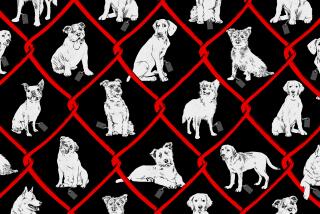ART : Ella’s Dogged Life : William Wegman once again dresses up his doleful but lovable Weimaraners, this time for a retelling of ‘Cinderella’ for his first children’s book
- Share via
“O nce upon a time there lived a rich widowed gentleman and his lovely young daughter. Ella, as she was named, was beautiful, adorable, and intelligent. Her father was devoted to her, and she in turn loved him. She caused her father no trouble at all, but for reasons we shall never know, he thought she needed a mother’s attention. He began looking for a wife. The woman he chose had two daughters about Ella’s age. ‘Perfect,’ he thought, ‘Ella will have a mother to care for her and two sisters as playmates. She will never be sad or bored.’ All he cared about was Ella. This seemed like a perfect arrangement. Before he could find out otherwise, he died.”
So begins artist William Wegman’s “Cinderella.”
If the text of this new book is familiar, the pictures are not. A troupe of Weimaraners acts out the fairy tale’s scenes in gorgeous reproductions of large-format (24-by-20-inch) Polaroids--which is to say the illustrations are vintage Wegman.
The 50-year-old artist is famous for taking photographs of doleful canines dressed up as everything from maids to dowagers or disguised as other animals. Wegman started photographing dogs in the ‘70s with his first Weimaraner, Man Ray, who became an art world celebrity long before the dog’s death in 1982. After an appropriate period of mourning, Wegman continued with Fay Ray (no relation to Man Ray) and her offspring Battina and Chundo.
But “Cinderella: Fay’s Fairy Tales” is Wegman’s first children’s book, and he acknowledges that illustrating a narrative with dressed-up dogs was daunting.
“It wasn’t a problem of the dogs being good. The dogs are always good, except for the puppies,” he said. “I just had no idea I could do the book the way I did. I hadn’t used sets before to that degree.”
Intrigued by the notion of doing a children’s book, Wegman found that his first challenge was “to figure out what story I could do with my characters--Fay, Battina and Chundo,” he said. Once he decided that Battina would be the perfect Cinderella, Chundo would make a charming Prince and the ever-versatile Fay could double as the Fairy Godmother and the Evil Stepmother--plus play a couple of bit parts--he had his answer.
Finding wigs and clothing for the dogs wasn’t easy, however. Neither was constructing the sets, which include such details as Cinderella wallpaper, glowing glass slippers and framed portraits of Weimaraners.
But the toughest part was orchestrating all the details in the pictures, including lighting and other technical problems posed by the cumbersome camera. No point-and-shoot, hand-held device, the immense Polaroid camera sat in one place at Wegman’s house in Maine while he and his assistants built sets in front of it.
When everything seemed to be in order, he would call the dogs and point out where they were to stand. Human friends would supply arms, hands, legs and feet as needed for the pictures, and Wegman would persuade the dogs to look in the right direction to complete the drama.
“Then the camera goes ‘poof’ and everybody groans ‘oh’ or yells ‘all right,’ ” he said. “You know what you have in a few seconds, but it usually takes about 20 shots--sometimes 40 shots--to get each picture.”
The trickiest scene appears to be a picture of six puppies hitched to a pumpkin coach. And, indeed, it took Wegman a couple of days to control the squirming pups, which were borrowed from a breeder in Maryland. But a shot of Cinderella’s ugly stepsisters preening in front of mirrors was actually more difficult, he said:
“That was the first shot I took, and you know how it is when you’re writing the first chapter of your novel. There were other people in the room, and other dogs. It was just a zoo of failure and exasperation, but on the second day it came together. The dogs were a challenge on certain shots, especially the little puppies. But none of these things did we have a map for. We had to learn how to do each thing on the day of the shot.”
One thing was relatively predictable: the dogs’ expressions. “The dogs always look sad, so you have to create happiness around them if you want to get joy in the picture, like in the marriage scene,” Wegman said. “But sometimes a magic thing happens, like they curl a lip and it’s better than you imagined.”
The secret to success in this improbable genre is 23 years of experience, Wegman said. “Plus if you have all this money and time and people involved, you get it done. I shot only for two weeks, but we planned for a year.”
He was paid about $100,000 for the book, but $85,000 of that sum went for renting the camera and shipping it to Maine. “Of course, I can sell the pictures,” he said. “Everybody wants to buy them, but I don’t want to sell them.”
Wegman’s photographs are definitely in demand, but he appears to leave himself open to charges of dog abuse.
“I have gotten letters of concern, and I always write back,” he said. “But anyone who has watched me work is not concerned with that. They can see how much the dogs like to work. If you think about it, I’ve been doing this for 23 years. I couldn’t abuse them, or they wouldn’t keep coming back for more. They are very sociable. They like being part of a big cast and getting treats and lunch.”
The dogs have already posed for “Little Red Riding Hood,” to be published in the fall as the second in Hyperion’s series of “Fay’s Fairy Tales.”
Meanwhile, Wegman is dreaming up additional projects for his favorite actors. “My next book might be for older children, up to 12 years of age,” he said, “and then maybe I’ll write my own story.”
Book signings for “Cinderella,” which was produced with Carole Kismaric and Marvin Heiferman (Hyperion: $16.95; 40 pp.), are scheduled at Book Soup in Hollywood on April 22, 7 p.m., and at Vroman’s in Pasadena on April 24, 10:30 a.m.
Wegman will be producing Polaroid portraits of human subjects at the Linda Cathcart Gallery in Santa Monica on April 23-26. Information: (310) 392-8578.
More to Read
Sign up for our Book Club newsletter
Get the latest news, events and more from the Los Angeles Times Book Club, and help us get L.A. reading and talking.
You may occasionally receive promotional content from the Los Angeles Times.










